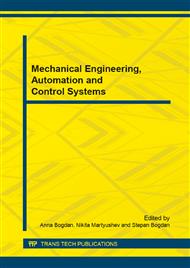[1]
J.B. Pendry, D. Shurig, D.R. Smith, Controlling electromagnetic fields, Science. 312 (2006) 1780-1789.
Google Scholar
[2]
A.E. Dubinov, L.A. Mytareva, Invisible cloaking of material bodies using the wave flow method, Phys. Usp. 53 (2010) 455-479.
DOI: 10.3367/ufne.0180.201005b.0475
Google Scholar
[3]
H. Liu, T. Zhou, Transformation optics and approximate cloaking, Contemp. Math. 559 (2011) 65-83.
Google Scholar
[4]
H. Liu, T. Zhou, Two dimensional invisibility cloaking via transformation optics, Disc. Cont. Dyn. Syst. Ser. A. 31 (2011) 526-543.
Google Scholar
[5]
G.V. Alekseev, Optimization in problems of material-body cloaking using the wave-flow method, Dokl. Phys. 58 (2013) 147-151.
DOI: 10.1134/s1028335813040071
Google Scholar
[6]
G.V. Alekseev, Control of boundary impedance in two-dimensional material-body cloaking the wave flow method, Comp. Math. and Math. Phys. 53 (2013) 1853-1869.
DOI: 10.1134/s0965542513120014
Google Scholar
[7]
G.V. Alekseev, A.V. Lobanov, Stability estimates for the solution to inverse extremal problems for the Helmholtz equation, J. Appl. Ind. Math. 7 (2013) 1-13.
DOI: 10.1134/s1990478913030034
Google Scholar
[8]
G.V. Alekseev, Cloaking via impedance boundary condition for 2-D Helmholtz equation, Appl. Anal. 93 (2014) 254-268.
DOI: 10.1080/00036811.2013.768340
Google Scholar
[9]
G.V. Alekseev, V.A. Levin, Optimization method of searching parameters of an inhomoge-neous liquid medium in the acoustic cloaking problem, Dokl. Phys. 59 (2014) 89-93.
DOI: 10.1134/s1028335814020013
Google Scholar
[10]
Yu. Yu. Fershalov, Technique for physical simulation of gasodynamics processes in the turbomachine flow passages, Russ. Aeron. 55 (2012) 424-429.
DOI: 10.3103/s1068799812040186
Google Scholar
[11]
Ju. Yu. Fershalov, T.V. Sazonov, Experimental research of the nozzles, Advan. Mater. Res. 915-916 (2014) 345-348.
DOI: 10.4028/www.scientific.net/amr.915-916.345
Google Scholar
[12]
M. Yu. Fershalov, A. Yu. Fershalov, Yu. Ya. Fershalov, Calculation of reactivity degree for axial lowaccount turbines with small emergence angles on nozzle devices, Advan. Mater. Res. 915-916 (2014) 341-345.
DOI: 10.4028/www.scientific.net/amr.915-916.341
Google Scholar
[13]
G.V. Alekseev, Solvability of stationary boundary control problems for thermal convection equations, Sib. Math. Zh. 39 (1998) 982-998.
DOI: 10.1007/bf02672906
Google Scholar
[14]
G.V. Alekeev, D.A. Tereshko, On solvability of inverse extremal problem for stationary equations of viscous heat conducting fluid, J. Inv. Ill-Posed Problems 6 (1998) 521-562.
DOI: 10.1515/jiip.1998.6.6.521
Google Scholar
[15]
G.V. Alekseev, D.A. Tereshko, The stationary optimal control problems for the viscous fluid equations, Sib. J. Indus. Math. 1 (1998) 22-44.
Google Scholar
[16]
G.V. Alekseev, D.A. Tereshko, Extremum problems of boundary control for stationary thermal convection equations, J. Appl. Mech. Tecn. Phys. 4 (2010) 72-84.
Google Scholar
[17]
G.V. Alekseev, I.S. Vakhitov, O.V. Soboleva, Stability estimates in problems of identification for the equation of convection-diffusions-reactions, Comput. Math. and Math. Phys. 52 (2012) 1635-1649.
DOI: 10.1134/s0965542512120032
Google Scholar
[18]
Information on: www. freefem. org.
Google Scholar


